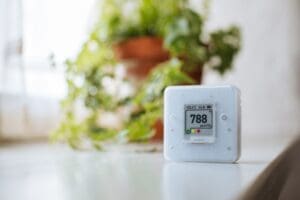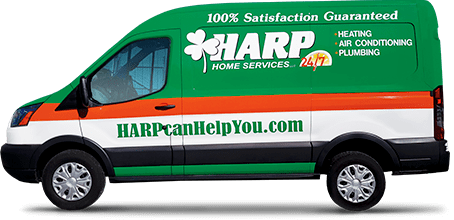
In today’s increasingly enclosed living standards, the quality of the air we breathe indoors can significantly impact our health and well-being. As we spend most of our time inside homes, offices, and other buildings, the importance of indoor air quality cannot be overstated.
In this article, we will explore what factors increase poor indoor air quality, the symptoms associated with it, and how to test and improve your indoor air quality.
What is Indoor Air Quality (IAQ)?
Indoor Air Quality (IAQ) refers to the air quality within and around buildings and structures, especially as it relates to the health and comfort of building occupants.
Which factor would increase poor indoor air quality?
Understanding and controlling common pollutants indoors can help reduce your risk of indoor health concerns.
Common examples of indoor pollutants include:
1. Indoor dust and pet dander allergens
Dust mites are microscopic bugs that live in carpet, bedding, upholstery, stuffed toys, and bedding. These bugs are invisible to the human eye but can majorly impact health. This is especially true for those already at risk, like the young, elderly, or those with allergies or asthma. Relatively minor effects include coughing, wheezing, and discomfort. At the same time, more severe implications can require medication or even hospitalization. Dander (dead skin cells sloughed off an animal’s coat) is the most common source of pet allergies. Pet dander clings to surfaces and makes its way into household cracks and crevices. Unfortunately, dander can linger for months in carpets, furniture, and even bedding! The result includes a variety of health issues for allergy sufferers.
Frequent cleaning at home – including vacuuming, frequent bedding changes, and wiping down surfaces – helps keep these pollutants at bay. Use a vacuum cleaner with a HEPA filter to reduce dust and pet dander concentrations in your home. A HEPA filter can also eliminate other toxins, including lead.
2. Volatile Organic Compounds (VOCs)
Volatile Organic Compounds (VOCs) are toxic airborne chemicals emitted as gases from certain solids or liquids. Top sources of VOCs in the home include paints, aerosol sprays, air fresheners, pesticides, dry-cleaned clothing, and cleansers.
Once airborne, these particles pose short and long-term health effects. According to the EPA, VOCs often cause eye, nose, and throat irritation, nausea, and damage to the liver, kidney, and central nervous system.
3. Bacteria, Germs, and Viruses
Poor indoor air quality can increase the risk of spreading highly contagious viruses like the cold and flu. More severe viruses, such as Coronavirus (COVID-19), are also a threat. Viruses are microscopic pathogens that need hosts to thrive. Once a virus enters the body, it begins to hijack healthy cells and reproduce at a significant pace. Bacteria or germs thrive in enclosed spaces and spread quickly through the air. Most bacteria are harmless. However, some strains of bacteria produce toxins that can kill cells and damage the immune system.
What are the symptoms of bad air quality in a house?
Indoor air pollutants may cause serious health concerns, such as:
- Nausea
- Dizziness
- Fatigue
- Sneezing
- Coughing
- Eye and skin irritations
- Congestion
- Headaches
- Allergic reactions
- Respiratory tract infections
- Asthma
The EPA states that indoor air is one of the top five environmental health risks of our time. In fact, indoor air has been found to contain up to 60 times more pollutants than outdoor air. A recent study by the American College of Allergy & Asthma states that polluted indoor air is the root cause of 40% – 50% of all illnesses.
How to Test the Air Quality in Your Home

Eliminating individual sources of pollution in the home can reduce indoor air pollutant concentrations and reduce emissions. Harmful pollutants may come from faulty appliance emissions, such as stoves or furnaces. Two out of three indoor air quality issues involve the poor performance and improper functioning of your HVAC (Heating Ventilation Air Conditioning) system. That’s why it’s crucial for a thoroughly trained indoor air quality technician to evaluate your home equipment annually.
Improving your indoor air quality can begin with tests for key pollutants known to impact health:
Test for Lead
Homes built before 1978 can benefit from a lead test, as most indoor and outdoor paints were lead-based before that time. Lead dust brought in from outside sources may also affect air quality in newer homes. Lead dust can be especially detrimental to children’s health in the home and may damage the brain, central nervous system, and kidneys. Use a vacuum cleaner with a HEPA filter to reduce concentrations of lead in your home. A HEPA filter can also eliminate toxins.
Test for Radon
Homeowners are encouraged to test for radon. Radon is a colorless, odorless, radioactive gas, making it impossible to detect without specialized testing. This gas typically moves up through the ground and into living spaces through cracks, gaps, or holes in the foundation. However, even airtight homes can potentially have it, and granite countertops have also been linked to radon.
Radon gas is prevalent in Connecticut, Pennsylvania, and many other states due to uranium deposits in the rock strata. Uranium off-gases radon as a by-product of mining activities.
The good news is that in-home radon testing is easy, reasonably inexpensive, and takes only a few minutes to complete. A radon test is highly recommended, as radon is the second leading cause of cancer in the United States according to the American Lung Association. In some cases, radon testing is required by certain lending institutions before the transfer of a property. Rest assured that with proper remediation equipment, even high radon levels can be reduced to acceptable levels.
Go to City Radon Zones to see what the average radon levels are in your neighborhood.
Test for Carbon Monoxide
Carbon monoxide (CO) is known as “The Silent Killer” in your home. Like radon, carbon monoxide is a toxic odorless, tasteless, and colorless gas. A buildup of CO in the home can lead to carbon monoxide poisoning or, in extreme cases, death.
CO can come from any device that burns fuel such as your furnace, water heater, stove, and dryer if they are not in good working condition or have not been installed with proper ventilation.
Symptoms of someone experiencing CO poisoning can include:
- Shortness of breath
- Mild nausea
- Headaches
- Dizziness
- Mental confusion
Since carbon monoxide does not have characteristics such as odor to alert you, the best way to keep your family aware of unsafe levels is to install carbon monoxide detectors throughout the house. A carbon monoxide alarm constantly samples the air, monitors for the presence of CO, and sounds an alarm when CO is detected at dangerous levels.
A HARP technician can service your furnace annually to prevent problems, such as carbon monoxide poisoning.
Test for Mold
Testing for mold spores in the air can be as simple as purchasing a mold test kit. Dust mites and mold love moisture. A healthy level of humidity at around 30%-50% will help keep your home free from mold and other allergens under control.
Using a dehumidifier and air conditioner during the summer months will help reduce moisture in indoor air and effectively control allergens. An efficient air conditioner will also lower indoor pollen count. As a side note, modern high-efficiency central air conditioning systems have smart thermostats that tell fans to ramp up or down, depending on particular needs, thus controlling humidity levels better than ever. Make sure your leaky plumbing gets repaired to prevent mold. From small portable tabletop air cleaners to whole-house systems, there are many tools to help make your IAQ healthier.
Additional resources to identify, correct, and prevent IAQ problems
- HVAC products and accessories for whole-home comfort
- Watch our Expert Advice Videos
- Read more expert tips and information on Indoor Air Quality
- Find Indoor Air Quality Testing Professionals and Services in Your Area
If you continue not feeling well, and have more dust and dirt in your home than you need, call us and make an appointment with one of our indoor air specialists. With our extensive training and experience, we can usually make recommendations with just an inspection of your home.
We also offer other HVAC services such as furnace repair, air conditioning installation, furnace replacement, and air conditioning repair. We use the latest tools to help determine the quality of your indoor air and can provide you with the products and services you need to improve your IAQ levels.
Let’s talk about the health of your air at home
Frequent coughing increased allergy issues, or frequent bouts of illness are the first sign the air quality in your home needs help. Noticeable dust and dirt in your home is another sign you need an IAQ plan! No matter what your indoor air quality challenge is, call now for an indoor air quality assessment by HARP Home Services.


